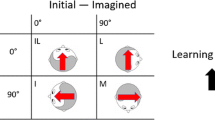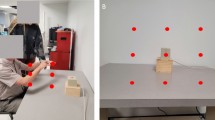Abstract
To produce accurate goal-directed arm movements, subjects must determine the precise location of target object. Position of extracorporeal objects can be determined using: (a) an egocentric frame of reference, in which the target is localized in relation to the position of the body; and/or (b) an allocentric system, in which target position is determined in relation to stable visual landmarks surrounding the target (Bridgeman 1989; Paillard 1991). The present experiment was based on the premise that (a) the presence of a structured visual environment enables the use of an allocentric frame of reference, and (b) the sole presence of a visual target within a homogeneous background forces the registration of the target location by an egocentric system. Normal subjects and a deafferented patient (i.e., with an impaired egocentric system) pointed to visual targets presented in both visual environments to evaluate the efficiency of the two reference systems. For normals, the visual environment conditions did not affect pointing accuracy. However, kinematic parameters were affected by the presence or absence of a structured visual surrounding. For the deafferented patient, the presence of a structured visual environment permitted a decrease in spatial errors when compared with the unstructured surrounding condition (for movements with or without visual feedback of the trajectory). Overall, results support the existence of an egocentric and an allocentric reference system capable of organizing extracorporeal space during arm movements directed toward visual targets.
Similar content being viewed by others
References
Acredolo LP (1977) Developmental changes in the ability to coordinate perspectives of a large-scale space. Dev Psychol 13:1–8
Acredolo LP (1978) Development of spatial orientation in infancy. Dev Psychol 14:224–234
Andersen RA (1987) Inferior parietal lobule function in spatial perception and visuomotor integration. In: Mountcastle VB (ed) Handbook of physiology. The nervous system. American Physiological Society, Bethesda (MA), pp 483–518
Bard C, Fleury M, Paillard J (1990) Different patterns in aiming accuracy for head-movers and non-head-movers. J Hum Mov Stud 18:37–48
Bard C, Paillard J, Lajoie Y, Fleury M, Teasdale N, Forget R, Lamarre Y (1991) Role of afferent information in the timing of motor commands: a comparative study with a deafferented patient. Neuropsychologia (in press)
Beaubaton D, Hay L (1986) Contribution of visual information to feedforward and feedback processes in rapid pointing movements. Hum Mov Sci 5:19–34
Biguer B, Jeannerod M, Prablanc C (1982) The coordination of eye, head and arm movements during reaching at a single visual target. Exp Brain Res 46:301–304
Bridgeman B (1989) Separate visual representations for perception and for visually guided behavior. Spatial display and spatial instruments. NASA, Moffett Field, Calif. pp 14(1)-14(15)
Bridgeman B (1991) Complementary cognitive and motor image processing. In: Obrecht G, Stark L (eds) Presbyopia research: from molecular biology to visual adaptation. Plenum Press, New York, pp 189–198
Bridgeman B, Lewis S, Heit G, Nagle M (1979) Relation between cognitive and motor-oriented systems of visual position perception. J Exp Psychol [Hum Percept] 5:692–700
Caminiti R, Johnson PB, Urbano A (1990) Making arm movements within different parts of space: dynamic aspects in the primate motor cortex. J Neurosci 10:2039–2058
Conti P, Beaubaton D (1980) Role of the structural field and visual reafference in accuracy of pointing movements. Percept Mot Skills 50:239–244
Cooke JD, Brown S, Forget R, Lamarre Y (1985) Initial agonist burst duration changes with movement amplitude in a deafferented patient. Exp Brain Res 60:184–187
Crossman ERFW, Goodeve PJ (1983) Feedback control of hand-movements and Fitts' law. Q J Exp Psychol [A] 35:251–278
Flanders M, Tillery SIH, Soechting JF (1991) Early stages in a sensorimotor transformation. Behav Brain Sci (in press)
Forget R, Lamarre Y (1987) Rapid elbow flexion in the absence of proprioceptive and cutaneous feedback. Hum Neurobiol 6:27–37
Forget R, Lamarre Y (1990) Anticipatory postural adjustment in the absence of normal peripheral feedback. Brain Res 508:176–179
Ghez C, Gordon J, Ghilardi MF, Christakos CN, Cooper SE (1990) Roles of proprioceptive input in the programming of arm trajectories. In: Cold Spring Harbor symposia in quantitative biology, vol. 55. Cold Spring Harbor Laboratory Press, Cold Spring Harbor, pp 837–847
Goldberg ME, Colby CL, Duhamel J-R (1990) Representation of visuomotor space in the parietal lobe of the monkey. In: Cold Spring Harbor symposia in quantitative biology, vol. 55, Cold Spring Harbor Laboratory Press, Cold Spring Harbor, pp 729–739
Grossberg S, Kuperstein M (1989) Neural dynamics of adaptive sensory-motor control. Pergamon Press, New York
Hatze H (1981) The use of optimally regularized Fourier series for estimating higher-order derivatives of noisy biomechanical data. J Biomech 14:13–18
Hay L (1990) Developmental changes in eye-hand coordination behaviors: preprogramming versus feedback control. In: Bard C, Fleury M, Hay L (eds) Development of eye-hand coordination across the life span. University of South Carolina Press, Columbia, pp 217–244
Honda H (1985) Spatial localization during pursuit-eye-movement conditions: A comparison of perceptual and motor measures. Percept Psychophys 38:41–46
Honda H (1990) The extraretinal signal from the pursuit-eye-movement system: its role in the perceptual and the egocentric localization systems. Percept Psychophys 48:509–515
Jeannerod M (1985) The posterior parietal area as a spatial generator. In: Ingle DJ, Jeannerod M, Lee DN (eds) Brain mechanisms and spatial vision. Martinus Nijhoff, Dordrecht, pp 279–298
Jeannerod M (1986) The formation of finger grip during prehension. A cortical mediated visuomotor pattern. Behav Brain Res 19:99–116
Jeannerod M (1988) The neural and behavioural organization of goal-directed arm movements. Clarendon Press, Oxford
Jeannerod M (1991a) The interaction of visual and proprioceptive cues in controlling reaching movements. In: Humphrey DR, Freund H-J (eds) Motor control: concepts and issues. Wiley, New York, pp 277–291
Jeannerod M (1991b) A neurophysiological model for the directional coding of reaching movements. In: Paillard J (ed) Brain and space. Oxford University Press, Oxford, pp 49–69
Jeannerod M, Michel F, Prablanc C (1984) The control of hand movements in a case of hemianaesthesia following a parietal lesion. Brain 107:899–920
Kesner RP, Farnsworth G, DiMattia BV (1989) Double dissociation of egocentric and allocentric space following medial prefrontal and parietal cortex lesions in the rat. Behav Neurosci 103:956–961
Lajoie Y, Paillard J, Teasdale N, Bard C, Fleury M, Forget R, Mamarre Y (1991) Mirror drawing in a deafferented patient and normal subjects: visuo-proprioceptive conflict. Neurology (in press)
Larue J, Fleury M, Blouin J, Bard C, Paillard J, Teasdale N, Forget R, Lamarre Y (1991) Arm movement control in a deafferented patient. IBRO, Montréal, August 1991, P39. 18, p 261
Lawler KA, Cowey A (1987) On the role of posterior parietal and prefrontal cortex in visuo-spatial perception and attention. Exp Brain Res 65:695–698
Meyer DE, Abrams RA, Kornblum S, Wright CE, Smith JES (1988) Models for the speed and accuracy of aimed movement. Psychol Rev 95:340–370
Meyer DE, Smith JE, Kornblum S, Abrams RA, Wright GE (1990) Speed-accuracy tradeoffs in aimed movements: toward a theory of rapid voluntary action. In: Jeannerod M (ed) Attention and performance. XII. Motor representation and control. Erlbaum, Hillsdale, pp 173–226
Paillard J (1982) Le corps et ses langages d'espace. In: Jeddi E (ed) Le corps en psychiatrie. Masson, Paris, pp 53–69
Paillard J (1987) Cognitive versus sensorimotor encoding of spatial information. In: Ellen P, Thinus-Blanc C (eds) Cognitive processes and spatial orientation in animal and man. Martinus Nijhoff, Dordrecht, pp 1–34
Paillard J (1991) Motor and representational framing of space. In: Paillard J (ed) Brain and space. Oxford University Press, Oxford, pp 163–182
Paillard J, Jordan P, Brouchon M (1981) Visual motion cues in prismatic adaptation: evidence of two separate and additive processes. Acta Psychol (Amst) 48:253–270
Prablanc C, Echallier JE, Jeannerod M, Komilis E (1979) Optimal response of eye and hand motor systems in pointing at a visual target. II. Static and dynamic visual cues in the control of hand movement. Biol Cybern 35:183–187
Ratcliff G (1991) Brain and space: some deductions from the clinical evidence. In: Paillard J (ed) Brain and space. Oxford University Press, Oxford, pp 237–250
Rebok GW (1987) Life-span cognitive development. Holt, Rinehart and Winston, Montréal
Rodler S, Euzet JP, Gahery Y, Paillard J (1991) Crossmodal versus intramodal evaluation of the knee joint angle. Hum Mov Sci 10: 689–712
Roland PE (1979) Voluntary movements and perception in intraand extrapersonal space. Behav Brain Sci 2:79–80
Roland PE, Skinhoj E, Lassen NA, Larsen B (1980) Different cortical areas in man in organization of voluntary movements in extrapersonal space. J Neurophysiol 43:137–150
Roll R, Bard C, Paillard J (1986) Head orienting contributes to the directional accuracy of aiming at distant targets. Hum Mov Sci 5:359–371
Rolls ET (1991) Functions of the primate hippocampus in spatial processing and memory. In: Paillard J (ed) Brain and space. Oxford University Press, Oxford, pp 353–376
Rothwell JC, Traub MM, Day BL, Obeso JA, Thomas PK, Marsden CD (1982) Manual motor performance in a deafferented man. Brain 105:515–542
Sanes JN, Mauritz K-H, Dalakas MC, Evarts EV (1985) Motor control in humans with large-fiber sensory neuropathy. Hum Neurobiol 4:101–114
Schmidt RA, Zelaznik HN, Hawkins B, Frank JS, Quinn JT (1979) Motor-output variability: a theory for the accuracy of rapid motor acts. Psychol Rev 86:415–451
Schmidt RA, Sherwood DE, Zelaznik HN, Leikind BJ (1985) Speed-accuracy trade-offs in motor behavior: theories of impulse variability. In Heuer H, Weinbeck U, Schmidt K-H (eds) Motor behavior: programming, control and acquisition. Springer Berlin Heidelberg New York
Soechting JF, Tillery SIH, Flanders M (1990) Transformation from head-to shoulder-centered representation of target direction in arm movements. J Cogn Neurosci 2:32–43
Sokal RR, Rohlf FJ (1982) Biometry. The principles and practice of statistics in biological research. Freeman, San Francisco
Stark L, Bridgeman B (1983) Role of corollary discharge in space constancy. Percept Psychophys 34:371–380
Stein JF (1991) Space and the parietal association areas. In Paillard J (ed) Brain and space. Oxford University Press, Oxford, pp 185–222
Teasdale N, Bard C, Fleury M, Tanoé M, Paillard J, Forget R, Lamarre Y (1991) The production of isometric force in a deafferented patient. IBRO, Montréal, August 1991, P39. 19, p 261
Ventre J, Flandrin JM, Jeannerod M (1984) In search of the egocentric reference. A neurophysiological hypothesis. Neuropsychologia 22:797–806
Worringham CJ (1991) The integration of “noise” into the structure of movements. In: Requin J, Stelmach GE (eds) Tutorials in motor neuroscience. Kluwer, Dordrecht, pp 443–456
Yardley L (1990) Contribution of somatosensory information to perception of the visual vertical with body tilt and rotating visual field. Percept Psychophys 42:131–134
Author information
Authors and Affiliations
Rights and permissions
About this article
Cite this article
Blouin, J., Bard, C., Teasdale, N. et al. Reference systems for coding spatial information in normal subjects and a deafferented patient. Exp Brain Res 93, 324–331 (1993). https://doi.org/10.1007/BF00228401
Received:
Accepted:
Issue Date:
DOI: https://doi.org/10.1007/BF00228401




